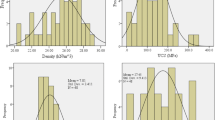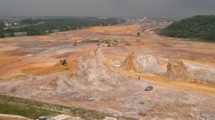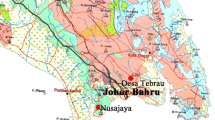Abstract
Brittleness index (BI) is a significant rock parameter when dealing with projects performed in rocks. The main goal of this research work is to propose the novel practical models to predict the BI through particle swarm optimization (PSO) and imperialism competitive algorithm (ICA). For this aim, two forms of equations, i.e., linear and power are considered and the weights of these equations are optimized by PSO and ICA. In the other words, four predictive models, namely ICA linear, ICA power, PSO linear, and PSO power models are developed to predict BI in this study. In the modeling of the predictive models, 79 datasets are used, so that Schmidt hammer rebound number, wave velocity, density, and Point Load Index (Is50) are selected as the independent (input) parameters and the BI values are considered as the dependent (output) parameter. Then, the performances of the proposed predicting models are checked using two error indices, namely coefficient correlation (R2) and root mean squared error (RMSE). The results showed that the PSO power model has superior fitting specification for the prediction of the BI compared to the other prediction models and is quite practical for use. As a result, linear and power models of PSO received higher performance prediction compared to ICA. PSO power (with R2 train = 0.937, R2 test = 0.959, RMSE train = 0.377 and RMES test = 0.289) showed the most powerful technique to predict BI of the granite samples.







Similar content being viewed by others
References
Miskimins JL (2012) The impact of mechanical stratigraphy on hydraulic fracture growth and design considerations for horizontal wells. Bulletin 91:475–499
Rickman R, Mullen MJ, Petre JE et al (2008) A practical use of shale petrophysics for stimulation design optimization: all shale plays are not clones of the Barnett Shale. SPE annual technical conference and exhibition
Wang Y, Watson R, Rostami J et al (2014) Study of borehole stability of Marcellus shale wells in longwall mining areas. J Pet Explor Prod Technol 4:59–71
Rybacki E, Reinicke A, Meier T et al (2015) What controls the mechanical properties of shale rocks?—Part I: Strength and Young’s modulus. J Pet Sci Eng 135:702–722
Rybacki E, Meier T, Dresen G (2016) What controls the mechanical properties of shale rocks?—Part II: Brittleness. J Pet Sci Eng 144:39–58
Hucka V, Das B (1974) Brittleness determination of rocks by different methods. Int J Rock Mech Min Sci Geomech Abstr 11:389–392
Altindag R (2000) The role of rock brittleness on analysis of percussive drilling performance. In: Proceedings of 5th national rock mechanics symposium, Turkey, pp 105–112
Yagiz S (2002) Development of rock fracture and brittleness indices to quantify the effects of rock mass features and toughness in the CSM model basic penetration for hard rock tunneling machines. Ph.D. Thesis, Department of Mining and Earth Systems Engineering, Colorado School of Mines, Golden, Colorado, USA, p 289
Meng F, Zhou H, Zhang C et al (2015) Evaluation methodology of brittleness of rock based on post-peak stress–strain curves. Rock Mech Rock Eng 48:1787–1805
Lawn BR, Marshall DB (1979) Hardness, toughness, and brittleness: an indentation analysis. J Am Ceram Soc 62:347–350
Nejati HR, Moosavi SA (2017) A new brittleness index for estimation of rock fracture toughness. J Min Environ 8:83–91
Safa M, Shariati M, Ibrahim Z et al (2016) Potential of adaptive neuro fuzzy inference system for evaluating the factors affecting steel-concrete composite beam’s shear strength. Steel Compos Struct 21:679–688
Toghroli A et al (2016) Potential of soft computing approach for evaluating the factors affecting the capacity of steel–concrete composite beam. J Intell Manuf. https://doi.org/10.1007/s10845-016-1217-y
Toghroli A, Mohammadhassani M, Suhatril M et al (2014) Prediction of shear capacity of channel shear connectors using the ANFIS model. Steel Compos Struct 17:623–639
Singh TN, Kanchan R, Saigal K, Verma AK (2004) Prediction of p-wave velocity and anisotropic property of rock using artificial neural network technique. J Sci Ind Res (India) 63:28–32
Momeni E, Nazir R, Armaghani DJ, Maizir H (2015) Application of artificial neural network for predicting shaft and tip resistances of concrete piles. Earth Sci Res J 19:85–93
Armaghani DJ, Hajihassani M, Sohaei H et al (2015) Neuro-fuzzy technique to predict air-overpressure induced by blasting. Arab J Geosci 8:10937–10950. https://doi.org/10.1007/s12517-015-1984-3
Shirani Faradonbeh R, Jahed Armaghani D, Abd Majid MZ et al (2016) Prediction of ground vibration due to quarry blasting based on gene expression programming: a new model for peak particle velocity prediction. Int J Environ Sci Technol 13:1453–1464. https://doi.org/10.1007/s13762-016-0979-2
Mohammadhassani M, Nezamabadi-Pour H, Suhatril M, Shariati M (2013) Identification of a suitable ANN architecture in predicting strain in tie section of concrete deep beams. Struct Eng Mech 46(6):853–868
Mohammadhassani M, Nezamabadi-Pour H, Suhatril M, Shariati M (2014) An evolutionary fuzzy modelling approach and comparison of different methods for shear strength prediction of high-strength concrete beams without stirrups. Smart Struct Syst Int J 14(5):785–809
Shah SNR, Sulong NHR, Shariati M, Jumaat MZ (2015) Steel rack connections: identification of most influential factors and a comparison of stiffness design methods. PLoS One 10(10):e0139422
Mansouri I et al (2016) Strength prediction of rotary brace damper using MLR and MARS. Struct Eng Mech 60(3):471–488
Mansouri I, Shariati M, Safa M et al (2017) Analysis of influential factors for predicting the shear strength of a V-shaped angle shear connector in composite beams using an adaptive neuro-fuzzy technique. J Intell Manuf. https://doi.org/10.1007/s10845-017-1306-6
Toghroli A et al (2018) Evaluation of the parameters affecting the Schmidt rebound hammer reading using ANFIS method. Comput Concr 21(5):525–530
Hamian M, Darvishan A, Hosseinzadeh M et al (2018) A framework to expedite joint energy-reserve payment cost minimization using a custom-designed method based on mixed integer genetic algorithm. Eng Appl Artif Intell 72:203–212
Khodaei H, Hajiali M, Darvishan A et al (2018) Fuzzy-based heat and power hub models for cost-emission operation of an industrial consumer using compromise programming. Appl Therm Eng 137:395–405
Nouri A, Khodaei H, Darvishan A et al (2018) Optimal performance of fuel cell-CHP-battery based micro-grid under realtime energy management: an epsilon constraint method and fuzzy satisfying approach. Energy 159:121–133
Darvishan A, Mollashahi H, Ghaffari V, Janghorban Lariche M (2018) Unit commitment-based load uncertainties based on improved particle swarm optimisation. Int J Ambient Energy. https://doi.org/10.1080/01430750.2017.1423384
Darvishan A, Bakhshi H, Madadkhani M et al (2018) Application of MLP-ANN as a novel predictive method for prediction of the higher heating value of biomass in terms of ultimate analysis. Energy Sour Part A Recover Util Environ Eff. https://doi.org/10.1080/15567036.2018.1514437
Reza Parsaei M, Mollashahi H, Darvishan A et al (2018) A new prediction model of solar radiation based on the neuro-fuzzy model. Int J Ambient Energy. https://doi.org/10.1080/01430750.2018.1456964
Liang M, Mohamad ET, Faradonbeh RS et al (2016) Rock strength assessment based on regression tree technique. Eng Comput. https://doi.org/10.1007/s00366-015-0429-7
Armaghani DJ, Mohamad ET, Narayanasamy MS et al (2017) Development of hybrid intelligent models for predicting TBM penetration rate in hard rock condition. Tunn Undergr Sp Technol 63:29–43. https://doi.org/10.1016/j.tust.2016.12.009
Khandelwal M, Armaghani DJ (2016) Prediction of drillability of rocks with strength properties using a hybrid GA-ANN technique. Geotech Geol Eng 34:605–620. https://doi.org/10.1007/s10706-015-9970-9
Hasanipanah M, Shahnazar A, Bakhshandeh Amnieh H, Jahed Armaghani D (2017) Prediction of air-overpressure caused by mine blasting using a new hybrid PSO–SVR model. Eng Comput. https://doi.org/10.1007/s00366-016-0453-2
Jahed Armaghani D, Mohd Amin MF, Yagiz S et al (2016) Prediction of the uniaxial compressive strength of sandstone using various modeling techniques. Int J Rock Mech Min Sci 85:174–186. https://doi.org/10.1016/j.ijrmms.2016.03.018
Sarkar K, Tiwary A, Singh T (2010) Estimation of strength parameters of rock using artificial neural networks. Bull Eng Geol 69:606
Singh TN, Verma AK (2012) Comparative analysis of intelligent algorithms to correlate strength and petrographic properties of some schistose rocks. Eng Comput 28:1–12
Kaunda RB, Asbury B (2016) Prediction of rock brittleness using nondestructive methods for hard rock tunneling. J Rock Mech Geotech Eng 8:533–540
Koopialipoor M, Fallah A, Armaghani DJ et al (2018) Three hybrid intelligent models in estimating flyrock distance resulting from blasting. Eng Comput. https://doi.org/10.1007/s00366-018-0596-4
Mendes R, Cortez P, Rocha M, Neves J (2002) Particle swarms for feedforward neural network training. In: Neural networks, 2002. IJCNN’02. In: Proceedings 2002 international joint conference IEEE, pp 1895–1899
Singh TN, Kanchan R, Verma AK, Saigal K (2005) A comparative study of ANN and neuro-fuzzy for the prediction of dynamic constant of rockmass. J Earth Syst Sci 114:75–86
Gordan B, Jahed Armaghani D, Hajihassani M, Monjezi M (2015) Prediction of seismic slope stability through combination of particle swarm optimization and neural network. Eng Comput 32:85–97. https://doi.org/10.1007/s00366-015-0400-7
Koopialipoor M, Armaghani DJ, Haghighi M, Ghaleini EN (2017) A neuro-genetic predictive model to approximate overbreak induced by drilling and blasting operation in tunnels. Bull Eng Geol Environ. https://doi.org/10.1007/s10064-017-1116-2
Mohamad ET, Faradonbeh RS, Armaghani DJ et al (2017) An optimized ANN model based on genetic algorithm for predicting ripping production. Neural Comput Appl 28:393–406
Hasanipanah M, Armaghani DJ, Amnieh HB et al (2018) A risk-based technique to analyze flyrock results through rock engineering system. Geotech Geol Eng. https://doi.org/10.1007/s10706-018-0459-1
Taheri K, Hasanipanah M, Golzar SB, Majid MZA (2017) A hybrid artificial bee colony algorithm-artificial neural network for forecasting the blast-produced ground vibration. Eng Comput 33(3):689–700
Keshtegar B, Hasanipanah M, Bakhshayeshi I, Sarafraz ME (2018) A novel nonlinear modeling for the prediction of blast-induced airblast using a modified conjugate FR method. Measurement 131:35–41. https://doi.org/10.1016/j.measurement.2018.08.052
Behzadafshar K et al (2018) Predicting the ground vibration induced by mine blasting using imperialist competitive algorithm. Eng Comput 35(4):1774–1787
Tashayo B et al (2018) Feasibility of imperialist competitive algorithm to predict the surface settlement induced by tunneling. Eng Comput. https://doi.org/10.1007/s00366-018-0641-3
Tian E et al (2018) Development of GA-based models for simulating the ground vibration in mine blasting. Eng Comput. https://doi.org/10.1007/s00366-018-0635-1
Yang X-S (2010) Firefly algorithm, Levy flights and global optimization. Res Dev Intell Syst XXVI:209–218 https://doi.org/10.1007/978-1-84882-983-1_15
Talbi E-G (2009) Metaheuristics: from design to implementation. Wiley, Oxford
Hasanipanah M, Jahed Armaghani D, Bakhshandeh Amnieh H et al (2016) Application of PSO to develop a powerful equation for prediction of flyrock due to blasting. Neural Comput Appl. https://doi.org/10.1007/s00521-016-2434-1
Armaghani DJ, Hasanipanah M, Amnieh HB, Mohamad ET (2018) Feasibility of ICA in approximating ground vibration resulting from mine blasting. Neural Comput Appl 29:457–465
Kennedy J, Eberhart RC (1995) A discrete binary version of the particle swarm algorithm. InSystems, man, and cybernetics, 1997. Computational cybernetics and simulation, 1997 IEEE international conference on, pp 4104–4108
Poli R, Kennedy J, Blackwell T (2007) Particle swarm optimization. Swarm Intell 1:33–57
Mohamad ET, Armaghani DJ, Momeni E et al (2016) Rock strength estimation: a PSO-based BP approach. Neural Comput Appl. https://doi.org/10.1007/s00521-016-2728-3
Hajihassani M, Jahed Armaghani D, Monjezi M et al (2015) Blast-induced air and ground vibration prediction: a particle swarm optimization-based artificial neural network approach. Environ Earth Sci 74:2799–2817. https://doi.org/10.1007/s12665-015-4274-1
Hajihassani M, Jahed Armaghani D, Kalatehjari R (2017) Applications of particle swarm optimization in geotechnical engineering: a comprehensive review. Geotech Geol Eng. https://doi.org/10.1007/s10706-017-0356-z
Hassan R, Cohanim B, De Weck O, Venter G (2005) A comparison of particle swarm optimization and the genetic algorithm. 46th AIAA/ASME/ASCE/AHS/ASC structures, structural dynamics and materials conference, p 1897
Atashpaz-Gargari E, Lucas C (2007) Imperialist competitive algorithm: an algorithm for optimization inspired by imperialistic competition. In: Evolutionary computation 2007. CEC 2007. IEEE congress IEEE, pp 4661–4667
Moayedi H, Jahed Armaghani D (2017) Optimizing an ANN model with ICA for estimating bearing capacity of driven pile in cohesionless soil. Eng Comput. https://doi.org/10.1007/s00366-017-0545-7
Hajihassani M, Jahed Armaghani D, Marto A, Tonnizam Mohamad E (2014) Ground vibration prediction in quarry blasting through an artificial neural network optimized by imperialist competitive algorithm. Bull Eng Geol Environ 74:873–886. https://doi.org/10.1007/s10064-014-0657-x
Marto A, Hajihassani M, Jahed Armaghani D et al (2014) A novel approach for blast-induced flyrock prediction based on imperialist competitive algorithm and artificial neural network. Sci World J. https://doi.org/10.1155/2014/643715
Taghavifar H, Mardani A, Taghavifar L (2013) A hybridized artificial neural network and imperialist competitive algorithm optimization approach for prediction of soil compaction in soil bin facility. Measurement 46:2288–2299
Hasanipanah M, Naderi R, Kashir J, Noorani SA, Qaleh AZA (2017) Prediction of blast-produced ground vibration using particle swarm optimization. Eng Comput 33(2):173–179
Hasanipanah M, Shahnazar A, Arab H, Golzar SB, Amiri M (2017) Developing a new hybrid-AI model to predict blast-induced backbreak. Eng Comput 33(3):349–359
Shahnazar A, Rad HN, Hasanipanah M, Tahir MM, Armaghani DJ (2017) A new developed approach for the prediction of ground vibration using a hybrid PSO-optimized ANFIS-based model. Environ Earth Sci 76(15):527
Hasanipanah M, Golzar SB, Larki IA, Maryaki MY, Ghahremanians T (2017) Estimation of blast-induced ground vibration through a soft computing framework. Eng Comput 33(4):951–959
Eskandar H, Heydari E, Hasanipanah M, Jalil Masir M (2018) Feasibility of particle swarm optimization and multiple regression for the prediction of an environmental issue of mine blasting. Eng Comput 35(1):363–376
Hasanipanah M, Noorian-Bidgoli M, Jahed Armaghani D, Khamesi H (2016) Feasibility of PSO-ANN model for predicting surface settlement caused by tunneling. Eng Comput 32(4):705–715
Hasanipanah M, Bakhshandeh Amnieh H, Arab H, Zamzam MS (2016) Feasibility of PSO–ANFIS model to estimate rock fragmentation produced by mine blasting. Neural Comput Appl. https://doi.org/10.1007/s00521-016-2746-1
Fouladgar N, Hasanipanah M, Bakhshandeh Amnieh H (2016) Application of cuckoo search algorithm to estimate peak particle velocity in mine blasting. Eng Comput. https://doi.org/10.1007/s00366-016-0463-0
Jahed Armaghani D, Hasanipanah M, Tonnizam Mohamad E (2016) A combination of the ICA-ANN model to predict airoverpressure resulting from blasting. Eng Comput 32(1):155–171
Acknowledgements
The authors would like to express their sincere appreciation to Dr. Armaghani for his cooperation in developing the idea of this research.
Author information
Authors and Affiliations
Corresponding author
Additional information
Publisher’s Note
Springer Nature remains neutral with regard to jurisdictional claims in published maps and institutional affiliations.
Rights and permissions
About this article
Cite this article
Hussain, A., Surendar, A., Clementking, A. et al. Rock brittleness prediction through two optimization algorithms namely particle swarm optimization and imperialism competitive algorithm. Engineering with Computers 35, 1027–1035 (2019). https://doi.org/10.1007/s00366-018-0648-9
Received:
Accepted:
Published:
Issue Date:
DOI: https://doi.org/10.1007/s00366-018-0648-9




